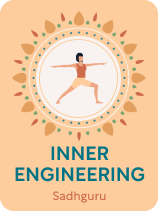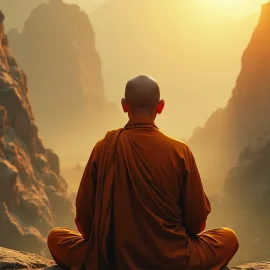

This article is an excerpt from the Shortform book guide to "Inner Engineering" by Sadhguru. Shortform has the world's best summaries and analyses of books you should be reading.
Like this article? Sign up for a free trial here.
What is Sadhguru’s Inner Engineering about? What’s the key message to take away from the book?
In Inner Engineering, renowned yogi Sadhguru provides readers with an introduction to the science of yoga and its transformative powers. Yoga, he explains, is not an exercise, nor a belief system—it’s a technology for managing your body, mind, and energy in a way that creates optimal conditions for your life.
Below is a brief overview of Inner Engineering: A Yogi’s Guide to Joy by Sadhguru.
Inner Engineering: A Yogi’s Guide to Joy
We live in a time of unprecedented global wealth and material comfort. We have all the resources we need to solve the world’s problems—and yet so many are suffering. Depression, anxiety, poverty, and violence plague us, while joy evades us. Why? In this book, yoga master Sadhguru explains that we create our own suffering and we’ll remain trapped in it until we learn to seek answers from the right place—inside ourselves. He says we can only transform the world by transforming ourselves from within, using yoga. And that’s what his “inner engineering” program teaches us to do.
In his book Inner Engineering, Sadhguru explains the yogic concepts behind his program. He says that to “engineer” something means to design it to be the way you want it. We engineer the world around us constantly, but we neglect to engineer our inner world. Yoga, he explains, is not an exercise, nor a belief system—it’s a technology for managing your body, mind, and energy in a way that creates optimal conditions for your life. If you manage your physical and mental processes consciously, Sadhguru says your whole life experience will be of your own making.
Shift your perspective and you’ll see miracles happen around you—not because anything external has changed, but because you’ll recognize the miracles that are already there. This shift can make your whole experience of life more joyful.
Sadhguru is a yoga master, mystic, and activist. Born in India in 1957, he has taught yoga since the 1980s and established The Isha Institute in Coimbatore, India in 1992. The institute offers regular classes, workshops, and retreats designed to teach attendants how to transform their lives through yoga and meditation. Sadhguru contributes much of his time and financial resources to environmental causes, including his Rally for Rivers project, an initiative to clean the polluted rivers of India. He’s also the author of Karma: A Yogi’s Guide to Crafting Your Destiny, published in 2021.
In this guide, we’ll explain what inner engineering is in three parts. In Part 1 we’ll explain the problems that Sadhguru says plague humanity. In Part 2 we’ll look at the solutions he proposes, including an explanation of what yoga is—and what it isn’t. Then, in Part 3 we’ll describe some of the practices Sadhguru offers so you can apply these concepts to your life.
Throughout the guide, we’ll compare Sadhguru’s approach to other spiritual self-help authors, and contextualize it within the larger tradition of yoga in the Hindu belief system.
Part 1: We Create Our Own Problems
To begin, we’ll outline some of the problems that plague humanity, and explain how Sadhguru’s background led him to his realizations. He says we create these problems for ourselves in two ways:
- We operate in survival mode, thus failing to reach the potential we have to transcend our basic instincts and become enlightened.
- We allow our thoughts and feelings to control us, rather than us controlling them.
Sadhguru says that everything in nature has the purpose of reaching its fullest potential, and all other life forms, from algae to spiders to ravens, do everything in their power to become the fullest expression of what they’re meant to be. Humans are the only creature that falls short of its potential. He says we’re like plants that begin as seeds but never sprout because the soil is bad. That “soil,” he says, is the state of our minds and bodies. And yoga is the mechanism for giving that seed of potential within us the right conditions to grow into what it’s meant to be.
Sadhguru’s Lifelong Yoga Practice Led Him to Realizations
Sadhguru came to his conclusions through a combination of teachings from other yogis and his own realizations via his lifelong yoga practice. From an early age, he was an exceptionally curious and precocious child who always sought to understand the world around him. When he was only 11 years old, he met a yogi and began learning yoga, which he practiced regularly from that day forward. As a young man, Sadhguru had become a somewhat rebellious, motorcycle-riding college student who would frequently abandon his classwork in favor of taking trips to the hills outside the city where he would meditate and do yoga.
On one of these occasions, he had a profound spiritual experience in which he transcended his normal consciousness and achieved a blissful sense of oneness with the universe. Over four hours passed in what felt to him like 10 minutes. This kind of transcendent experience began happening more and more regularly, and during these states he began to have realizations that changed his perspective on life and set him on the path to becoming the guru and yoga master he is today. These mystical experiences allowed him to access what he thinks of as the universal intelligence—the all-knowing consciousness that pervades everything—which we’ll discuss more later in the guide.
So, Sadhguru’s realizations come from his own personal transcendental experiences and also draw upon a long tradition of yogic teachings. Since, according to yogic philosophy, there is just one ultimate reality, or universal intelligence, there is a high degree of congruence among the thousands of years of yogic teachings.
Therefore, he says yoga is a technology that transforms your body and mind into a tool for serving your highest purpose, by accessing the universal intelligence, or the consciousness that pervades everything. And he says anyone can do it—it’s applicable in any life and any time period, as it transcends time, history, and circumstance.
Realization: Survival Mode Keeps Us From Reaching Our Potential
Sadhguru says our most fundamental problem as a species is that we’re denying our oneness with the universe. Instead, we create illusions of separateness and division in all aspects of life. We’ve created boundaries for ourselves by categorizing everything—we decide things are good or bad, right or wrong, and so on. Although understanding the world this way is a survival tactic that helps us make sense of things, when we want to move beyond survival mode, it works against us.
On the most basic level, Sadhguru says, all humans just want to feel good, and everything else we pursue in life is a means to that end. And yet we tend to be plagued with discontent. When we attain one thing, we experience fleeting pleasure, and then we fall into dissatisfaction again and start seeking the next remedy. This is an endless cycle of suffering. According to Sadhguru, this is because we’re seeking contentment from things outside of ourselves, when the source of the discontent lies within us.
Sadhguru says the root of this cycle of suffering is our deep unconscious knowledge that we belong in union with everything in the universe but we’re not living that way. We’re unable to experience this feeling of “oneness” because:
1) We’re stuck in limiting patterns of thought: We’ve divided the whole world up into categories and judgments, and we live as though they’re facts, when they’re really just human constructs. For example, manmade ideas about race, gender, and morality create conflict and inhibit us from achieving our potential.
2) We believe we’re separate from others: Thinking of ourselves as entirely separate beings from everyone else encourages egocentrism and limits compassion. We must realize we’re all interconnected with one another on an energetic level.
3) We identify with our bodies and minds: Believing that you are your body or even your mind keeps you feeling trapped, restricted, and fearful of mortality.
Sadhguru emphasizes that you are neither your body nor your mind. You are the one who’s in charge of them. What we all really need, he says, is to move from being bounded by distinctions to feeling ourselves a part of the unbounded universe. This involves getting our bodies, minds, and energy in a state of optimal functioning, and thereby transforming the way we perceive ourselves and life. This is what yoga is designed to do.
Realization: We Allow Our Thoughts and Emotions to Control Us
The second layer of our problematic human nature, according to Sadhguru, is that instead of being in control of our own thoughts, we allow them to control us. Because we allow ourselves to be at the whim of our emotional states, we try to arrange the world around us to create circumstances that make us feel good, rather than directing our own minds and feelings. This is always precarious, he says, because there’s so much in life that we can’t control.
Sadhguru asks: How can your own thoughts make you miserable when you generate your thoughts? Why would you do that to yourself? And yet, he points out, we have thoughts that constantly make us suffer. You need to learn to be in charge of your own mind, instead of allowing your mind to control you. Sadhguru says practicing yoga will help you recognize the distinction between you and your mind.
You perceive them as products of your external circumstances, but Sadhguru says you need to recognize that all of your experience is generated within you. You think someone is “making” you angry, or your job “makes” you stressed. But, while that person or job may be what triggers these states, the anger and stress are inside you, and therefore you’re generating these feelings, and you can choose not to.
Sadhguru says the concepts of “stress management” and “anger management” assume those are inevitable facets of our lives that we must learn to manage. This is a false assumption. He says we don’t need to accept these as inevitable—we can totally eliminate them from our lives. It’s simply a matter of how we respond to situations.
So, Sadhguru says you must move from being a passive victim of circumstance to an active master of your own life. This means making a shift from being “reactive” (having an unconscious reaction) to being “responsive” (having a conscious response). In other words, making conscious choices about how to be in every moment.
Part 2: Yoga Is the Solution to Our Suffering
So now that we know our problems come from our own mental constructs, how do we go about solving them? Sadhguru says yoga provides all the techniques we need to transform our inner lives so that we can move beyond our limitations and reach our highest potential.
What Yoga Is Not
To get an accurate understanding of yoga, we need to first recognize that people in the Western world tend to misunderstand it. What we think of as yoga is just one of the many forms, Sadhguru explains—and even that form we tend to misunderstand.
1. Yoga is not exercise, or a means for getting “fit.” The yoga we’re most familiar with in modern Western cultures, involving stretching postures, is hatha yoga. But people tend to focus only on the physical part of it. Sadhguru says that’s totally inefficient because the physical and spiritual must work together. If you do it for “exercise,” it’ll still bring you some benefit, but not as much as if you understand the real purpose and intentionally use it for a mind-body transformation.
2. Yoga is not an end goal in itself. Hatha yoga is the science of aligning your body with the energy of the universe. Hatha is meant to be a preparatory practice for a bigger (spiritual) goal, not an end in itself. For example, long periods of meditation require your physical body to be in good shape, so you can sit comfortably. Successful meditation practice therefore requires getting the body in shape. Flexibility is also not the goal. But Sadhguru says your body posture both affects and reflects your state of consciousness. So this form of yoga uses body postures intentionally to elevate your consciousness. He says your body is like an antenna—how you hold it determines the reception you get.
3. Yoga is not a religion or a belief system. Sadhguru emphasizes that this book does not offer any doctrine or belief system to follow. It simply allows you to understand the mechanism by which you can transform your life. Yoga is about a radical self-transformation, involving a fundamental shift in the way you perceive life. And he stresses that none of it needs to be taken on faith. It’s all testable and experiential.
Even “spirituality” doesn’t refer to anything supernatural, according to Sadhguru. He says religion as a whole is totally unnecessary. “Divine love” and “god” are not something in a faraway supernatural realm—they’re part of us, accessible inside of all of us. Likewise, “eternal life” or “heaven” are not something relegated to an afterlife—we have access to eternity just by getting in touch with that infinite dimension of life. We need to realize that the “divine” is very real, but it’s all natural and part of us as humans.
4. Yoga is not exclusive or unattainable. Spiritually, Sadhguru says everyone is equal, and therefore equally capable of transforming through yogic practices. You don’t need to retreat to a cave. You only need to spend a few minutes a day enhancing your awareness of your internal state.
What Yoga Is
Now that we understand what yoga is not, what is it? Sadhuguru says that, put simply, yoga is a tool for developing self-mastery, allowing you to consciously create your experience of life. Through it, you can experience union with the energy of the universe and eliminate your fear of suffering and concern about self-preservation—in other words, you can enjoy living and stop worrying about dying. When these fears are gone, you can experience life fully and be fine in any situation.
This self-mastery must happen on multiple levels. Sadhguru explains that according to yogic philosophy, we’re composed of five layers, or “bodies”:
- The physical body (often called the “food body” in yogic terminology)
- The mental body (your thoughts and emotions)
- The energy body (how your energy flows through you)
- The etheric body (extraordinary knowledge accessed through transcendental states)
- The bliss body (a state of enlightenment)
Sadhguru says you only need to work with the first three layers. The final two are not accessible until you’ve worked with the first three, and once you’ve done that work, they’ll naturally follow. So all the instructions in this book are for obtaining mastery over your body, mind, and energy.
Yoga as a whole is the combination of methods for improving the condition of your body, mind, and energy. We will take an in-depth look at each.
The Body
Your body runs automatically and is in a constant process of creation. We don’t need to tell our lungs to breathe, our hearts to beat, or our hair to grow. But Sadhguru says that rather than experiencing our bodies’ processes unconsciously, we should consciously observe them so we can feel the miracle of creation working within us.
Sadhguru says that intelligence is not just in our minds—it’s also stored in our bodies. He distinguishes between “knowledge” as accumulated information, and “knowing,” which he describes as the dynamic intelligence of life. Everything living is imbued with knowing. Every cell in your body is intelligent—they operate without you ever having to think a thought. Think about how birds instinctively know how to migrate thousands of miles at the right time of year, or how spiders know how to craft exquisitely detailed webs. How do they know how to do those things? This knowing, Sadhguru says, is not stored in their minds; it’s stored in their bodies. And he says that our bodies also have this kind of knowing stored within them—the information about our purpose and how to fulfill it.
Our bodies know on a deeper level how to achieve a higher state of consciousness through connecting to the intelligence of the universe. But we tend to not recognize it, to not be in touch with it, because of the problems discussed in Part 1 of this guide. This is why it’s crucial that we learn to listen to and honor our bodies, Sadhguru says. Practicing yoga is a process of recreating your body so it can serve its highest purpose, connecting you with the higher intelligence of the universe. Yoga enhances and expands your perception of life beyond the five outward senses. This vastly enriches your experience of life.
Because the body is the vehicle for your material existence, Sadhguru explains, keeping it in its optimal state is necessary for your mind and energy to function at their optimal states. Therefore, yoga includes consciousness around diet. Food is important in yogic practice because:
- Your body is made of it. We literally are what we eat, in the sense that every component of your body is created from the materials it gets from the food you eat.
- How you consume and digest food affects the functioning of your body and mind and ultimately your whole experience of life.
There are no moral judgments around food in yogic philosophy, according to Sadhguru. Yoga simply requires eating what’s most conducive to the functioning of our bodies, which he says is a plant-based diet of unprocessed foods. For example, he emphasizes that although meat consumption is discouraged for a yoga practitioner, this is not based in morality. It’s because animal products and processed “junk” foods don’t provide the optimal energy, nutrition, and digestive conditions for your body. As your body consciousness increases with yoga practice, he says you’ll instinctively know what to eat.
The Mind
Sadhguru explains that in yogic philosophy, the mind is categorized into four parts: intellect, memory, identity, and awareness. A major problem we face is the imbalance of these four aspects of the mind because we tend to filter everything through our intellect, memory, and identities while neglecting our awareness. The four aspects of the mind work as follows:
- Intellect: This is the thinking mind that’s concerned with survival and tends to divide and categorize things in order to understand the world. The intellect judges everything based on sensory input and what it has stored.
- Memory: This is the part of the mind that stores the judgments you’ve accumulated over time. It can keep us trapped in the past as well as distort new information based on the impressions that are stored there.
- Identity: This part of our mind includes the impressions of ourselves that we accumulate over time. Identity distinguishes us from others, and therefore divides and limits us.
- Awareness: This is the pure consciousness aspect of your mind that is engaged when we practice mindfulness.
Sadhguru explains that awareness (called chitta in yogic terminology) is a way of knowing that is not influenced by our memories and identities. It allows us to discriminate what’s actually true from what our mind is saying based on its distorted perceptions and social conditioning. Our task in yoga is to develop our awareness, in order to move beyond our boundaries and enhance our experience of life.
Sadhguru also argues that awareness exists on a continuum. When we’re asleep we’re in our most limited state of awareness. When we’re awake, we’re in a mid-range state of awareness. When we’re enlightened, we’re in a state of full awareness. So, he says, our everyday consciousness is a reduced state of awareness—and we’re not even cognizant of it. Just like when we’re sleeping, we’re not cognizant of the fact that we’re asleep; we only realize it by comparison when we wake up. The same happens with enlightenment.
Sadhguru says in yogic terminology, a well-developed human mind is called a kalpavriksha, which translates to “wishing tree.” This means that when our minds are in their optimal state—an enlightened state—whatever we wish for becomes reality because we create our own reality. You don’t need to have faith to manifest this, he says. You just need to have commitment to the process, which involves the following steps:
- Figure out what you really want, with as much clarity as possible.
- Commit to creating it.
- Establish a steady stream of thought in that direction.
The trick, Sadhguru says, is getting that first step right. We may think that’s the easiest step, but it’s actually the most difficult. That’s because, he says, when your mind is in its limited state, you don’t have clarity about what you want. You desire things that don’t really end up making you happy and fulfilled. Many people think they know what they want, but this is muddied by social expectations, judgments about what we’re supposed to want and do, and limiting ideas about what’s possible.
For example, we may spend our lives pursuing wealth, because that’s what we’re conditioned to believe is equated with success. Or we may not pursue our dreams because we believe they’re unrealistic. Sadhguru says the work of inner engineering needs to be undertaken to get your mind to the point where it has a clear vision, unsullied by our conditioned beliefs.
Energy and Transcendence
Science tells us that all things are made of energy. This means at the most fundamental level, you are just energy in one particular manifestation. So, according to Sadhguru, because you’re just energy manifesting in different forms, and energy is all there is, that means you are all that is. When religions say God is everywhere, or in everything, they’re really saying this using religious language. Sadhguru says what we really long for is to be able to feel this—to have the sensual experience of being that universal energy. He describes it as a blissful, expansive, liberating experience. This is also known as a transcendental experience or a mystical state.
Kriya yoga is the method for achieving energetic transcendence. It’s specifically energy-focused, rather than body or mind focused. Sadhguru says you should get your body and mind prepared first, and only move forward with kriya practices if you want to experience mystical states of consciousness. He warns that it’s not easy—it takes devotion and practice. Yogis have developed these methods over thousands of years, so when you practice kriya yoga you must adhere to the regimen with discipline.
Sadhguru does, however, point out that a strict path of kriya yoga is only for those who are committed to experiencing real mystical experiences. If you’re not, you can still employ basic kriya techniques to enhance your life experience—you can increase joy and creativity and attract positivity to your life through raising your energy.
When you work to transform yourself in body and mind, Sadhguru says you must keep up those practices or the effects will wear off. Think, for example, of how you get out of shape if you don’t keep exercising. But he says any work you do toward transforming your energy is permanent. You will change yourself on a fundamental level.
Part 3: Practices to Begin Your Inner Engineering
As mentioned earlier, this book focuses more heavily on the philosophical concepts behind Sadhguru’s yogic methods. But he does offer some basic practices you can do to begin to put some of these concepts to work in your life. In this section, we’ll briefly describe a few of those practices. The blog section of Sadhguru’s Isha Institute website has more practices and advice.
Get in Touch With the Five Elements
Sadhguru says that according to yogic practice, everything is composed of five elements: earth, air, water, fire, and ether. His advice: Begin to think of the world around you in terms of these five elements, and acknowledge them with reverence. For example, when you drink water, consciously acknowledge it as a sacred element; when you walk on the ground, look at the dirt and recognize it as the sacred element of earth. If you interact with the world this way, you’ll begin to see the world around you as sacred.
Practice Fasting
Yogic practice often involves periods of fasting. Sadhguru says when you’re attuned enough with your body, you’ll intuitively know when you need to fast. Until then, skip eating for one day every 14 days. If you can’t fast, then eat only fruit on this day.
Replace Sleep With Rest
If you keep yourself in a relaxed state throughout the day, you’ll need less sleep. Sadhguru says he only sleeps 4 to 5 hours per night. He says he can do this because he stays in a peaceful, restful state throughout the day. Your body needs rest more than it needs actual sleep. Notice how you will naturally sleep less if you practice yoga and meditation during the day.
Get Your Mind Out of the Gutter
According to Sadhguru, one of the major ways we limit ourselves is by identifying with our physical bodies. Focusing on sex traps us in our physical bodies and doesn’t allow for spiritual growth. Sex is a natural biological drive, Sadhguru says. We should neither deny it nor focus on it. Every other animal just acts on this imperative when they need to, and otherwise it has nothing to do with their lives. They don’t sit around dwelling on it, nor do they deny it when it’s necessary.
Regular exposure to pornography can lead to several harmful effects: sex addiction, desensitization to real-life sexual experiences, unrealistic expectations, and the objectification of women. A 2014 scientific study found decreases in activity in several areas of the brains of regular porn viewers, and suggested that porn can negatively alter brain structure and function.)
Feed the Ants
Sadhguru tells the story of his mother, who practiced devotion to her family and to the world by always eating the food she had prepared last. Not only did she serve her family before herself, but she would also take a small amount of food outside to give to the ants before she sat down to eat. This was not to devalue herself, but to honor others. It was to remind herself that everything living has value and that the ants deserved to live just as much as she did. In order to raise your awareness of your connection to everything, and to acknowledge and honor the sacredness of all life, take a bit of food outside and feed the ants before you eat.
Consecrate Your Home Space
Temples are consecrated spaces that are meant to inspire us to connect with something higher. Consecration is done with ritual practices and sounds that raise the energetic vibration of a place. Spaces in nature will also naturally have higher energy, and some specific spots are very intensely energetic. People visit temples and nature for the purpose of recharging their energy. But Sadhguru says you can consecrate a space in your home as well. He recommends invoking the elements by doing the following:
- Use some sort of grain, such as rice flour, and draw a six-pointed star on a table. This is what’s known as the “star of David” in the Jewish tradition. The star will represent the air element.
- Place a shallow bowl of water in the center. This brings in the water element.
- Place in the bowl of water a small oil lamp or candle, and a flower. These represent fire and earth.
- Do this each evening, allowing the lamp/candle to burn for a while. You will start to notice an energetic shift in your room.
Practice Devotion
Sadhguru says that being a yogi means practicing devotion to all of life. In order to practice devotion, he says you should begin bowing down to whatever is around you throughout the day. Once an hour, put your hands together in a prayer position, and bow to whatever is in front of you. He says it doesn’t matter what it is, just bow down. Increase the frequency of this, and eventually you can transition to just doing it in your mind, and begin doing it all day long. He says a true devotee dissolves himself into everything around him, and this is the way to begin to dissolve yourself.

———End of Preview———
Like what you just read? Read the rest of the world's best book summary and analysis of Sadhguru's "Inner Engineering" at Shortform.
Here's what you'll find in our full Inner Engineering summary:
- An introduction to the science of yoga and its transformative powers
- Renowned yogi Sadhguru's journey of self-discovery
- Why yoga is not meant to be an exercise or a way to get "fit"






